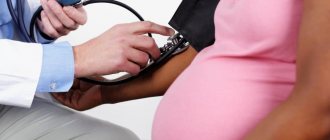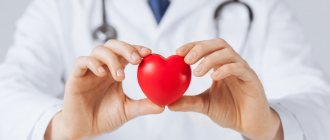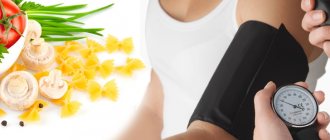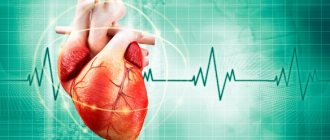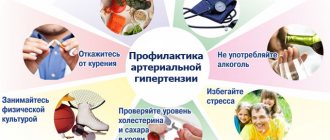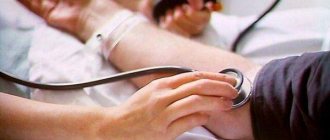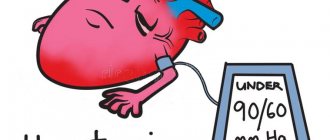Causes of diseases
According to statistics, hypertension is much more common than hypotension. A number of factors can lead to its occurrence:
- disorders of the nervous system (regular stress, depression);
- abuse of alcohol and tobacco products;
- unbalanced diet (frequent consumption of salty, fried and fatty foods);
- abnormalities of the endocrine system (obesity);
- increased physical activity;
- genetic predisposition;
- the occurrence of atherosclerotic lesions of the arteries.
Hypotonic disease can develop as a result of the following reasons:
- serious disturbances in the functioning of the cardiovascular system (for example, heart failure);
- infectious blood diseases (sepsis);
- lack of vitamins in the body;
- disturbances in the functioning of the digestive system;
- vegetative-vascular dystonia (VSD);
- decreased vascular tone (in particular, anaphylactic shock);
- change of usual climatic conditions.
Hypertension and low blood pressure
People who have crossed the forty-year mark of their age automatically fall into the risk group. But there are cases when this insidious disease affects very young people. Its causes are varied, but the main reason, that is, the root of the disease, is a person’s incorrect lifestyle and poor nutrition. It is generally accepted that a sign of hypertension is high blood pressure.
However, doctors say that this is not the main symptom, since often people come to them with an already diagnosed diagnosis, and their complaints are about low blood pressure. Why does this happen? Low blood pressure in hypertension can be explained by two factors. Firstly, this is the so-called physical inactivity. This happens when a person moves very little for one reason or another. With sustained physical inactivity, the body begins to restructure itself. During physical inactivity, less blood flows to the internal organs. The brain also receives less blood. In response to this, the brain sends a command to the vasomotor center to reduce the pressure.
The organism obeys the command of the main manager of the organism. The second factor is worn-out heart muscle. High blood pressure causes the heart to work harder. And the higher the pressure, the correspondingly greater the load on the heart muscle. When working hard, the heart, in simple terms, gets tired and stops working in the mode that the brain sets for it. The result is low blood pressure. What should you do if you are diagnosed with hypertension and your blood pressure drops? The first thing that must be done is to check the contractility of the heart. It can be detected by simply doing an ECG and echo of the heart.
If it shows normal contractility, then you should do regular physical exercise. Physical education will eliminate the symptoms of physical inactivity, and blood pressure will return to normal levels. You should start physical activity with the simplest physical exercises. They need to be performed a minimum number of times so as not to overtire the body. In this mode, physical training can be continued for several months.
If, during physical training, shortness of breath, discomfort in the heart area, and dizziness still appear, then the loads need to be reduced further. But there’s no point in stopping your classes! All these symptoms are a sign that the body is getting used to new conditions. Traditional medicine recipes can successfully help achieve average blood pressure levels during physical inactivity. Plants that alleviate physical inactivity include: radiola rosea, ginseng root, aralia root, eleutherococcus, thistle leaves. Also, the symptoms of physical inactivity are easily relieved by drinks such as coffee, tea with ginger. It should be noted that hypertension is incurable. This means that the presence of antihypertensive drugs in the first aid kit has not been canceled, even with persistent remission. Hypertensive patients should also know that antihypertensive drugs do not accumulate in the body and cannot be taken for future use. These drugs are completely eliminated from the body within two days. Long-term remission with a diagnosis of hypertension is very rare. It can only be observed in those people who have been ill recently and the disease is still diagnosed as the initial stage of hypertension.
Symptoms and signs of diseases
In the initial stages, symptoms of the disease may show virtually no symptoms. It has been noted that hypertension is much worse compared to hypotension, although some symptoms may be similar. Let's look at the most common symptoms characteristic of each disease separately.
Hypertension:
- Frequent headaches (migraines).
- Darkening of the eyes, “floaters” before the eyes.
- Rapid heartbeat (often accompanied by tingling and pain in the chest area).
- Congestion of the ears, the appearance of noise in them.
- Difficulty breathing (shortness of breath).
- Facial redness.
- Increased sweating of the palms and other parts of the body.
Hypotension:
- Pale skin.
- Loss of consciousness.
- Throbbing headache in the temples.
- Increased fatigue.
- Unstable emotional state (irritability, apathy).
- Feelings of nausea occur.
- General weakness and malaise of the body.
It is not recommended to ignore the above symptoms. A timely visit to a cardiologist will allow you to identify the disease at an early stage and prescribe the most appropriate treatment.
What is normal pressure?
The World Health Organization has compiled a special table that can be used to determine how normal your blood pressure is. Please note: “optimal pressure” is an indicator at which the risk of developing cardiovascular diseases is practically absent.
| Blood pressure category | Systolic (upper) blood pressure mm Hg. Art. | Diastolic (lower) blood pressure mm Hg. Art. |
| Norm | ||
| Optimal | Less than 120 | Less than 80 |
| Normal | Less than 130 | Less than 85 |
| Increased normal | 130–139 | 85–89 |
| Hypertension | ||
| 1st degree (transient) | 140–159 | 90–99 |
| 2nd degree (moderate) | 160–179 | 100–109 |
| 3rd degree (severe) | More than 180 | More than 110 |
| Border | 140–149 | Less than 90 |
| Isolated systolic hypertension | More than 140 | Less than 90 |
Which disease is more dangerous?
Both diseases are dangerous for humans and, in the absence of timely treatment, can lead to a number of negative consequences. Hypertension is accompanied by impaired blood supply to tissues and internal organs. As a result of this, the muscular organ functions with increased load, and a compensatory increase occurs. This can lead to the following ailments: decreased vision, poor circulation, the development of coronary heart disease and acute renal failure.
Hypotension significantly reduces the level of quality of life and seriously affects ability to work. If it continues for a long time, the patient may begin bleeding from internal organs and develop diseases of the endocrine system (for example, hypothyroidism).
Publication date: 04/25/2018 14:24:06
Weather against blood vessels
The fact that meteosensitivity is the first sign of an abnormal pressure level is not a myth, but a real proven fact. You probably yourself have noticed that any change in the weather (it doesn’t matter whether it’s a cold snap or, conversely, a thaw) entails a deterioration in well-being, headaches, and weakness. Meanwhile, doctors have recorded that strokes, heart attacks, and heart attacks occur precisely when weather conditions change. What is the pattern of interaction between us and the planet’s atmosphere? It's simple.
Article on the topic
What causes high blood pressure? 7 facts about hypertension
In hot weather, a lot of water evaporates from the body, and accordingly the density of the blood increases and it thickens. Cold provokes vascular spasms, and as a result - poor circulation. In any case, the heart begins to work with increased tension, which leads to a change in blood pressure. And this causes vascular overstrain. And if the vessels are sick and unstable to external influences, hemorrhage can occur, that is, a stroke.
Where does hypertension lead?
“Hypertension” is translated from Greek as “overtension.” This term most often refers to an increase in blood pressure, which inevitably leads to hypertension.
The approach of hypertension is characterized by weather sensitivity, drowsiness, and weakness when the weather changes. Over time, hypertension threatens to move into a more serious phase, in which there is a deficiency of hormones that regulate the state of the vascular system. That is, the body will completely stop coping with even small temperature changes. The appearance of hypertension can also be preceded by kidney disease, a hereditary factor, age-related changes in blood vessels, and endocrine disorders during menopause.
Myths and facts about blood pressure
In case of any blood pressure disorders, it is necessary to check the thyroid gland. This is true. The thyroid gland, although small, is a very hardworking organ. And even when it fails, you may not always feel it right away. Meanwhile, the lack of its hormones affects the functioning of the heart and can cause a slowdown in its rhythm (less than 60 beats per minute), heart failure, and lower or increase blood pressure.
Instead of doctors, you can seek advice from “experienced hypertensive patients” - they will tell you how to quickly lower your blood pressure. This is the wrong way of thinking. There are more than six different groups of antihypertensive (i.e., blood pressure-lowering) drugs. And each group has its own indications and contraindications for use. Even within the same group, drugs vary greatly in their properties and are selected individually, depending on the dynamics of blood pressure fluctuations, concomitant diseases and the general condition of the person.
Treatment of hypertension leads to impotence in men. This statement is not unfounded. Some drugs designed to treat hypertension cause decreased sexual function. But, firstly, they only reduce libido and have no effect on erectile functions. And secondly, even for such an effect a very long course is needed.
Don't bog me down with statistics!
40% men and 41% of women in Russia suffer from high blood pressure.
45% premature deaths occur due to strokes and heart attacks caused by hypertension. That is, almost every second person in Russia dies due to diseases that began with just high blood pressure.
12% of men and 25% of women after 45 years of age are interested in their blood pressure and measure it regularly, the rest simply do not pay attention to the alarming symptoms.
Features and weaknesses of hypotensive patients
Arterial hypotension is often considered a pleasant bonus from nature, since in this case you do not face dangerous blood pressure levels and complications associated with hypertension. The cause of constantly reduced pressure is often impaired regulation of vascular tone, which can be a symptom of vegetative-vascular dystonia.
Low blood pressure is often accompanied by dizziness, morning sickness, weakness and fatigue. This makes life significantly more difficult for those who cannot boast of pressure above 100/60 mmHg. Art. Therefore, people with hypotension have habits that may seem whimsical, but at the same time help to adapt to the characteristics of the body.
- Coffee in bed.
People with arterial hypotension are physically unable to wake up when the alarm clock rings: normal vascular tone and heart rate are restored within a few minutes after waking up. And if they do risk getting out of bed abruptly, they may lose consciousness, or at least be forced to sit down and wait until the dizziness and tinnitus end. Therefore, it is better for them to wake up with a light stretch of their legs, then sitting on the bed. If no one brings you tea or coffee “in bed,” then leave a glass of water next to your bed in the evening and drink it immediately after waking up. - Only comfortable temperature
. Poor thermoregulation is a frequent companion to hypotension. In hot weather, a person with arterial hypotension will experience weakness and suffer from a lack of oxygen and headaches. If you have to sit motionless in a poorly heated office or lecture hall, a hypotensive person has a hard time: his hands and feet get cold, he feels drowsy and definitely wants to eat. At the same time, labor productivity is poor, and there is a regular desire to go out for a smoke break or coffee. Opt for coffee: it will raise your blood pressure a little and keep you warm - although it's important not to overdo it with coffee. - Intolerance to hunger and thirst
. Low blood pressure often occurs in people who are asthenic in physique. This combination of physiological qualities leads to the fact that there are very few energy reserves, and if a person cannot eat on time, then his health sharply worsens and his mood deteriorates. All this does not at all indicate a bad character, but indicates the vulnerability of a hypotensive person. Lack of water reduces the volume of circulating blood, and the already low blood pressure decreases further, which can lead to fainting. - High demands on air quality
. Since with arterial hypotension the partial pressure of blood gases is reduced, the efficiency of gas exchange is lower than with normal blood pressure. Therefore, every milliliter of oxygen in the air we breathe is important. In a stuffy room, such a person feels very bad, and this is primarily due to a lack of oxygen in the brain. - Physical laziness
.
If you once again cannot drive yourself to the gym, or simply do exercises at home, then this laziness may be due to your physiology. Physical weakness is characteristic of hypotensive people, and each workout can subsequently lead to long-term restoration of strength, cause migraines, and temporary disturbances in heart rhythm. Therefore, you need to start training with arterial hypotension gradually, evenly distributing forces, without competing with anyone. To improve adaptation to physical activity and avoid unpleasant consequences, take the drug Eltacin® , which consists of the amino acids: glutamic acid, glycine and cystine. This way you will support the heart, improve vascular regulation, and gradually increase physical endurance.
